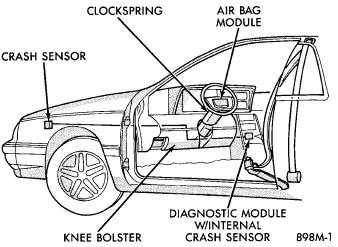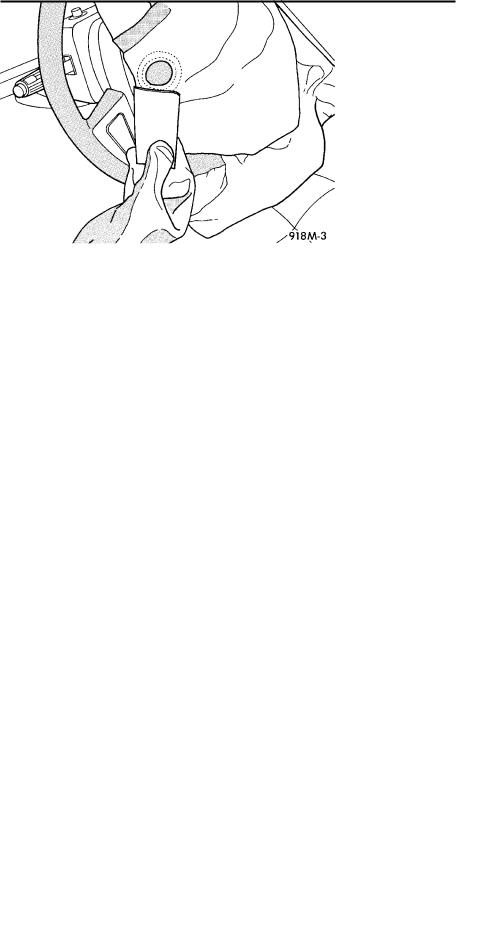
- •CONTENTS
- •AIR BAG SERVICE AND TEST PROCEDURES
- •GENERAL INFORMATION
- •AIR BAG MODULE
- •FRONT IMPACT SENSORS
- •CLOCKSPRING
- •DIAGNOSTIC MODULE
- •STORAGE
- •HANDLING LIVE MODULE
- •DEPLOYED MODULE
- •CLEANUP PROCEDURE
- •SERVICE OF DEPLOYED AIR BAG MODULE
- •SCHEDULED MAINTENANCE INSPECTION
- •AIR BAG SYSTEM CHECK
- •AIR BAG MODULE
- •REMOVAL
- •INSTALLATION
- •LEFT FRONT IMPACT SENSOR
- •REMOVAL
- •INSTALLATION
- •RIGHT FRONT IMPACT SENSOR
- •REMOVAL
- •INSTALLATION
- •AIR BAG SYSTEM DIAGNOSTIC MODULE (ASDM)
- •REMOVAL
- •INSTALLATION
- •CLOCKSPRING
- •REMOVAL
- •INSTALLATION
- •CLOCKSPRING CENTERING PROCEDURE
- •STEERING WHEEL
- •REMOVAL
- •INSTALLATION
- •STEERING COLUMN SWITCHES
- •REMOVAL
- •INSTALLATION

Ä |
|
RESTRAINT SYSTEMS 8M - 1 |
|
RESTRAINT SYSTEMS
CONTENTS
|
page |
AIR BAG MODULE . . . . . . . . . . . . . . . . . . . . . |
. . 3 |
AIR BAG SERVICE AND TEST PROCEDURES |
. . 1 |
AIR BAG SYSTEM CHECK . . . . . . . . . . . . . . . |
. . 3 |
AIR BAG SYSTEM DIAGNOSTIC MODULE |
|
(ASDM) . . . . . . . . . . . . . . . . . . . . . . . . . . . . |
. . 5 |
CLOCKSPRING . . . . . . . . . . . . . . . . . . . . . . . . |
. . 5 |
CLOCKSPRING CENTERING PROCEDURE . . . . . 6 |
|
AIR BAG SERVICE AND TEST PROCEDURES
WARNING: THIS SYSTEM IS A SENSITIVE, COMPLEX ELECTRO-MECHANICAL UNIT. BEFORE ATTEMPTING TO DIAGNOSE, REMOVE OR INSTALL THE AIR BAG SYSTEM COMPONENTS, YOU MUST FIRST DISCONNECT AND ISOLATE THE NEGATIVE (GROUND) BATTERY CABLE. FAILURE TO DO SO COULD RESULT IN ACCIDENTAL DEPLOYMENT AND POSSIBLE PERSONAL INJURY.
WHEN AN UNDEPLOYED AIR BAG ASSEMBLY IS TO BE REMOVED FROM THE STEERING WHEEL, DISCONNECT BATTERY GROUND CABLE AND ISOLATE. ALLOW SYSTEM CAPACITOR TO DISCHARGE FOR TWO MINUTES THEN BEGIN AIR BAG SYSTEM COMPONENT REMOVAL.
Vehicles equipped with a Air Bag System must be inspected every three years or 30,000 miles / 48,000 Km. To inspect system use Passive Restraint System Diagnostic Procedures Manual.
If the Air Bag Module Assembly is defective and non-deployed, refer to Chrysler Motors current return list for proper handling procedures.
WARNING: REPLACE AIR BAG SYSTEM COMPONENTS WITH CHRYSLER MOPART SPECIFIED RE-
PLACEMENT PARTS. SUBSTITUTE PARTS MAY VISUALLY APPEAR INTERCHANGEABLE, BUT INTERNAL DIFFERENCES MAY RESULT IN INFERIOR OCCUPANT PROTECTION.
THE FASTENERS, SCREWS, AND BOLTS, ORIGINALLY USED FOR THE AIR BAG COMPONENTS, HAVE SPECIAL COATINGS AND ARE SPECIFICALLY DESIGNED FOR THE AIR BAG SYSTEM. THEY MUST NEVER BE REPLACED WITH ANY SUBSTITUTES. ANYTIME A NEW FASTENER IS NEEDED, REPLACE WITH THE CORRECT FASTENERS PROVIDED IN THE SERVICE
|
page |
GENERAL INFORMATION . . . . . . . . . . . . . . |
. . . . 1 |
LEFT FRONT IMPACT SENSOR . . . . . . . . . . |
. . . 4 |
RIGHT FRONT IMPACT SENSOR . . . . . . . . . |
. . . 5 |
SCHEDULED MAINTENANCE INSPECTION |
. . . . 3 |
STEERING COLUMN SWITCHES . . . . . . . . . |
. . . 7 |
STEERING WHEEL . . . . . . . . . . . . . . . . . . . . |
. . . 7 |
PACKAGE OR FASTENERS LISTED IN THE |
|
PARTS BOOKS. |
|
GENERAL INFORMATION |
|
AIR BAG MODULE
The air bag module is the most visible part of the system (Fig 1). It contains the air bag cushion and its supporting components. The air bag module contains a housing to which the cushion and inflator are attached and sealed.
Fig. 1 Air Bag Passive Restraint System
The inflator assembly is mounted to the back of the module housing. When supplied with the proper electrical signal the inflator assembly will produce a gas and discharges it directly into the cushion. A protective cover is fitted to the front of the air bag module and forms a decorative cover in the center of the steering wheel. The air bag module is mounted directly to the steering wheel.
FRONT IMPACT SENSORS
The driver air bag system is a safety device designed to reduce the risk of fatality or serious injury, caused by a frontal impact of the vehicle.

8M - 2 RESTRAINT SYSTEMS
The impact sensors provide verification of the direction and severity of the impact. Three impact sensors are used. One is called a safing sensor. It is located inside the diagnostic module which is mounted on the floor pan, just forward of the center console. The other two sensors are mounted on the upper crossmember of the radiator closure panel on the left and right side of the vehicle under the hood.
The impact sensors are threshold sensitive switches that complete an electrical circuit when an impact provides a sufficient G force to close the switch. The sensors are calibrated for the specific vehicle and react to the severity and direction of the impact.
CLOCKSPRING
The clockspring is mounted on the steering column behind the steering wheel, and is used to maintain a continuous electrical circuit between the wiring harness and the driver's air bag module. This assembly consists of a flat ribbon-like electrically conductive tape which winds and unwinds with the steering wheel rotation.
DIAGNOSTIC MODULE
The Air Bag System Diagnostic Module (ASDM) contains the safing sensor and energy reserve capacitor. The ASDM monitors the system to determine the system readiness. The ASDM will stored sufficient energy to deploy the air bag for only two minutes after the battery is disconnected. Unless both front impact sensors are open the air bag could be deployed up to 9.5 minutes after the battery is disconnected. The ASDM contains on-board diagnostics, and will illuminate the AIR BAG warning lamp in the cluster when a fault occurs.
STORAGE
The air bag module must be stored in its original special container until used for service. Additionally, it must be stored in a clean, dry environment, away from sources of extreme heat, sparks, and sources of high electrical energy. Always place or store the module on a surface with the trim cover facing up to minimize movement in case of accidental deployment.
HANDLING LIVE MODULE
At no time should any source of electricity be permitted near the inflator on the back of the module. When carrying a live module, the trim cover should be pointed away from the body to minimize injury in the event of accidental deployment. In addition, if the module is placed on a bench or other surface, the plastic trim cover should be face up to minimize movement in case of accidental deployment.
When handling a steering column with an air bag module attached, never place the column on the floor or other surface with the steering wheel or module face down.
Ä
DEPLOYED MODULE
The vehicle interior may contain a very small amount of sodium hydroxide powder, a byproduct of air bag deployment. Since this powder can irritate the skin, eyes, nose or throat, be sure to wear safety glasses, rubber gloves and long sleeves during cleanup (Fig. 2).
Fig. 2 Wear Safety Glasses and Rubber Gloves
If you find that the cleanup is irritating your skin, run cool water over the affected area. Also, if you experience nasal or throat irritation, exit the vehicle for fresh air until the irritation ceases. If irritation continues, see a physician.
CLEANUP PROCEDURE
Begin the cleanup by putting tape over the two air bag exhaust vents (Fig. 3) so that no additional powder will find its way into the vehicle interior. Then remove the air bag and air bag module from the vehicle.
Use a vacuum cleaner to remove any residual powder from the vehicle interior. Work from the outside in so that you avoid kneeling or sitting in a uncleaned area.
Fig. 3 Seal the Air Bag Exhaust Vents
